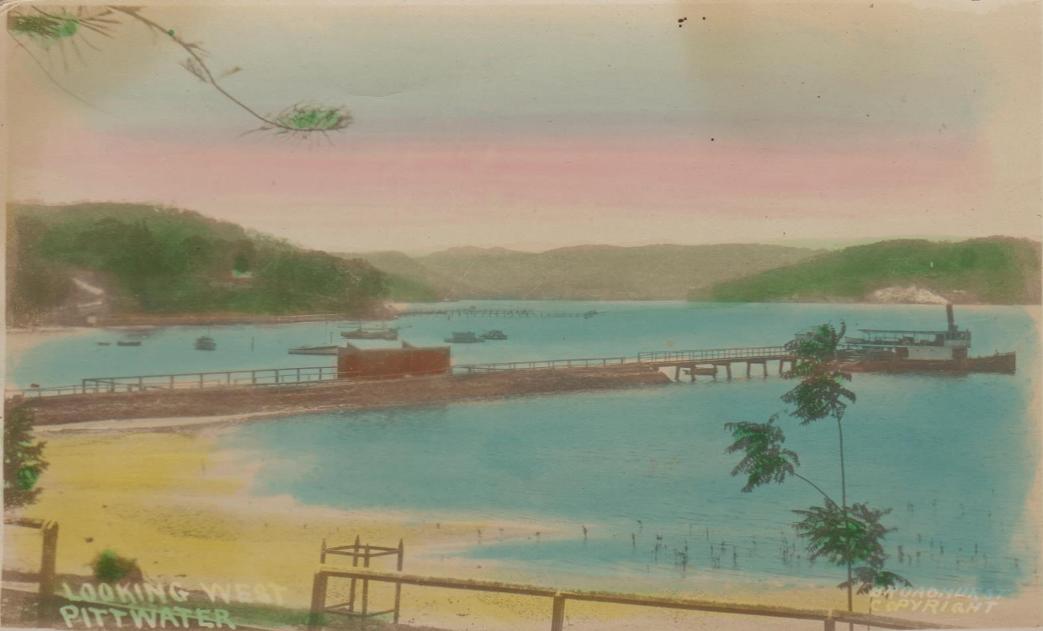January 12 - 18, 2014: Issue 145
Pittwater Summer Mix January 2014
As in previous years we reason a lot of people have a little more time to relax and indulge in curling up with stories and records dear to Pittwater's heart. This week:
A Steamer to Pittwater, A Run to Pittwater, A Trip to Pittwater and A Brief Respite - In Pittwater! - with a few snippets of added in extra bits and food for thought conjecture - remember we keep adding material to all history pages as and when found - so if you can shed some more light, all will be grateful.
Before we were suburban we were all 'in the country' and many were exhorting others to board a steamer, to coach it, walk or 'tramp' it, or sail away..., but Get Thee to Pittwater - to her estuary, to her beaches and bays, to her virgin bush western foreshores! - more breaths from over a hundred years ago - in 1862 and 1880 we go east, in 1889 - to the west, and in 1907 - let's sail north then go south for a bit!
Pittwater.
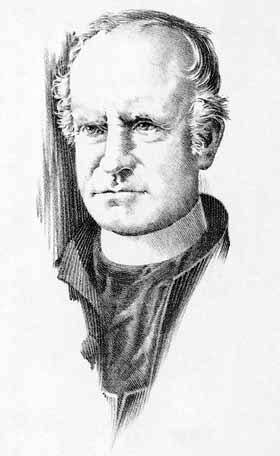 It is not without reason that we boast of the many beauties that almost every nook and corner of the shores of Sydney Harbour offer to our view; the numbers of our citizens who, upon occasions of public rejoicing, flock to the principal points of interest are a sufficient proof of the thorough appreciation of them by the inhabitants of our fair city; but, great as are the attractions which we are accustomed to look upon with so much pleasure, there are others which possess the additional recommendations of novelty. We are not about to insinuate that the attractions of the numerous favourite localities in the harbour are by any means exhausted — 'rather, we should say, that the increase of appetite for the charms of Nature which lie at, we may say, our very doors grows by what it feeds on, if we may judge of the public taste by the greatly increasing number of visitors to the most celebrated localities in the harbour; but still, it is a matter of some surprise that the Heads should so long remain the Ultima Thule of our excursionists, and that the numerous beautiful spots on the shores of the Pacific, within easy distance of Sydney, should be comparatively, Terra Incognita to its inhabitants.
It is not without reason that we boast of the many beauties that almost every nook and corner of the shores of Sydney Harbour offer to our view; the numbers of our citizens who, upon occasions of public rejoicing, flock to the principal points of interest are a sufficient proof of the thorough appreciation of them by the inhabitants of our fair city; but, great as are the attractions which we are accustomed to look upon with so much pleasure, there are others which possess the additional recommendations of novelty. We are not about to insinuate that the attractions of the numerous favourite localities in the harbour are by any means exhausted — 'rather, we should say, that the increase of appetite for the charms of Nature which lie at, we may say, our very doors grows by what it feeds on, if we may judge of the public taste by the greatly increasing number of visitors to the most celebrated localities in the harbour; but still, it is a matter of some surprise that the Heads should so long remain the Ultima Thule of our excursionists, and that the numerous beautiful spots on the shores of the Pacific, within easy distance of Sydney, should be comparatively, Terra Incognita to its inhabitants.
We heard, therefore, with great pleasure that, on Easter Monday, the ordinary rule of excursions was about to be broken through by the members of St. Benedict's Young Men’s Society and their friends, and that the 'Collaroy' had been engaged to land them on Father Therry's property at Pittwater, in Broken Bay, whence they could proceed to view St. Michael's Cave, that celebrated natural curiosity, to which we have already called attention in the Freeman's Journal. The day, fortunately, was most propitious for a sea trip, there being scarcely any wind to raise the fears of those to whom a voyage outside the Heads is looked upon as rather an adventurous enterprise — the long, majestic roll of the mighty ocean tending rather to add a zest to the pleasures of the voyage to those who are not affected by the vial de mer, so distressing to its victims, but which; unfortunately, meets with so little sympathy from those who have the good fortune to escape it.We were, however, very much pleased to see that there were very few who suffered in the slightest degree from this unwelcome concomitant to the pleasures of a sea voyage, and that those who underwent the ordeal of a slight attack recovered themselves long before our destination was reached.
The 'Collaroy,' under the command of Captain Mulhall, left the A. S. N. Co.'s Wharf shortly after ten o'clock; and as she is known to be one of the fastest boats sailing from the port of Sydney, she steamed gallantly down the harbour and along the coast to her place of destination. As we proceeded along the coast, the constant succession of beautiful scenery excited the admiration of every one onboard — many points on the coast, by their calm and placid beauty, calling to mind the parks and woodlands same of us have been accustomed to see at Home, than those spots untouched by the hand of man, and where Nature still reigns supreme.
Passing Burraujuee Head, which spreads out East and West like the head or a hammer at the end of along, narrow isthmus, which may not inaptly he compared to the handle, we steamed up Pittwater, and entered tint arm on its Eastern side upon which Father Therry's property is situated. As we proceeded up the Bay, the beautiful scenery on every side — so similar in its general character to that of our own harbour, and yet so different in its arrangement and general effect — excited the unqualified admiration of everyone on board. The situation of Pittwater and the beautiful country which surrounds it on every side renders it particularly available for the foundation of a watering place, which it will probably be at no distant period, when it becomes fashionable, for our citizens and their families to seek for change of air and scene during the heats of summer.
The steamer having landed its freight at the wharf constructed by Father Therry for the convenience of persons residing in the locality, and for those excursionists to whom he might give permission to land upon his property, they proceeded to walk towards the Cave, one of the chief attractions of the day's excursion. The path lay across a pleasant, undulating country to the rocks fronting the ocean, on the face of which the Cave is situated. A path has been constructed on the ledges of rock jutting out from the face of the cliff, and presenting in some places difficulties of approach to it which might have deterred many from venturing on the expedition had they been aware of them. The steps were frequently so steep and narrow that the slightest slip might have subjected a person to serious injury by precipitating him from a height of thirty or forty feet on to the rocks below, very similar to those at the base of the Gap, and against which the waves dashed with violence as great as we see at that spot, with which so much melancholy interest is associated. After what we had heard of the Cave itself, we certainly were rather disappointed on gaining the entrance: it is only by scrambling over the rooks, taking up a position at the extreme end and looking back towards the entrance that the full solemnity of the scene can be realised. The dim unearthly light streaming through the entrance and broken up by the projections of the roof and sides left an impression upon the mind not easily to be effaced; it was a fitting scene for all the horrors of the incantation scene in per Freischutz, its resemblance to which was rendered more striking by numbers of bats which flitted to and fro through the gloom;or to that scene in Macbeth where the Weird Sisters' Round about the cauldron go.'
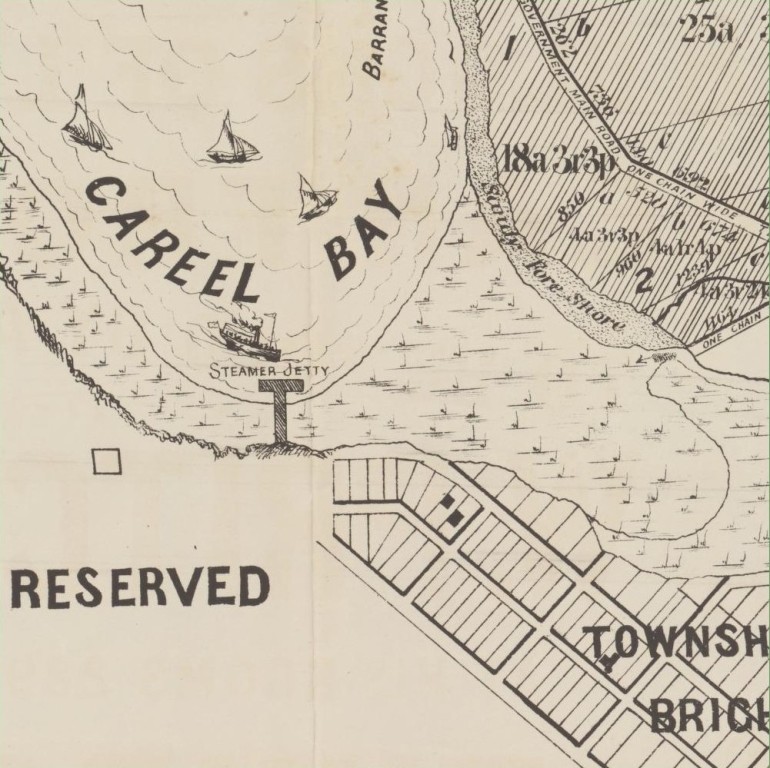
The cave is certainly a very curious and interesting object, and but for its distance from Sydney would, without doubt, be a source of' great attraction to our pleasure seekers. Unfortunately a shower of rain, which fell between two and three o'clock, caused a slight interruption to the pleasures of the day by preventing the anticipated pleasure of a dance upon the green sward, but this little contretemps caused a great degree of attention to be paid to the creature comforts, the steward of the steamer being kept constantly employed in providing for the numbers of persons visiting the cabin to partake of the excellent lunch be had provided, and for which, be it remembered, he did not fail to charge a price considerably higher than we have been accustomed to see paid on similar occasions.
It was intended that Father Therry should have delivered the inaugural lecture of the season of St. Benedict's Society in St. Michael’s cave, but he was compelled, with great reluctance, to turn back without having reached it, having found the journey too fatiguing for him.
A great number of the excursionists scattered themselves in the bush and on the shores which skirt the beautiful bay, and several employed themselves in shooting and fishing. The Collaroy left Pitt Water about six o'clock in the evening and arrived in Sydney a little after eight no accident having occurred to mar the pleasures of a most agreeable day. Among the guests onboard we noticed the Very Rev. J. J. Therry Archpriest, Rev. Dr. Powell and Fathers Anselm, Corish, Donovan, McGirr, the Mayor of Sydney, with Mrs Oatley and family, &c. &c. The Band of the12th Regiment had been engaged by the committee and played a selection of drama and other music which tended greatly to increase the pleasures of the day.
We must not omit to mention the extremely discreditable conduct of those who without asking any permission of Father Therry, on whose property St. Michael's cave is situated, very coolly advertised the Kembla to proceed there on another occasion at a less rate than the Collaroy, to the great annoyance and discomfort of those who had asked and obtained permission of Father Therry to make use of his ground. We are informed that an exorbitant price, no less than £70, was asked for the use of the Kembla for Easter Monday, her proprietors no doubt imagining that no other vessel suitable for the excursion was to be obtained, but finding afterwards that the Collaroy had been engaged, they immediately advertised the Kembla to go to the same place at a cheaper rate, thereby preventing many persons from going by the Collaroy who would in all probability have done so. There cannot be the slightest doubt that making use of a private landing place and with the greatest coolness taking possession of a gentleman's land to picnic upon and walk about is just as much a trespass as walking unbidden into his drawing room, and we are certainly surprised that a gentleman bearing the high character of Messrs. Manning should have in any way lent themselves to so mean and discreditable an act. We hope, however, that this hint will be sufficient to prevent a recurrence of a similar proceeding and that the first excursion of St. Benedict' s Young Men's Society having proved so agreeable to all who attended it we may have the pleasure of attending others as agreeable when a like opportunity is offered us. PITTWATER. (1862, April 23). Freeman's Journal (Sydney, NSW : 1850 - 1932), p. 6. Retrieved from http://nla.gov.au/nla.news-article115761495

Wreck of the S.S. Collaroy, 1881 / photographer unknown, Image No.: a1528938, courtesy State Library of NSW.
A TRIP TO PITTWATER.
Some friends of mine having purchased part of the Pittwater estate recently offered for sale, were anxious to see the land, and they invited me to accompany them. Saturday last was fixed for the trip. On that morning we were all up betimes. The night before we agreed that whoever rose earliest should call the others. Being known to rise on the first sound of the ' cock's shrill clarion,' I was expected to rouse my friends. At 5 o'clock when I went to do so I found that one of them had been up two hours, the others even longer. They had evidently worried themselves into wakefulness all night, for which there was no necessity, as a late sleeper might catch the first Manly boat, by which we were to leave Sydney. Saturday morning broke in smiling silence on the city and suburbs: it was one of those mornings which call forth praise and prayer to heaven for the blessing of such a climate as we enjoy in this Southern land. The waters of the harbour from our point of view (the heights of North Shore)looked like several lakes which were as calm as millponds. Our unrivalled harbour, it appears to me, presents scenes at, daybreak and by moonlight that cannot be viewed at any other time.
In summer mornings, before the sun rises, you may see creeping over the waters of its various nooks and bays gauze-like exhalations, which magnify the ships and boats in the stream. On the appearance of the great, vaporizer the mist is dispelled and the grand picture we all admire is unveiled. The nocturnal beauty of Port Jackson one never ceases to admire. Music only is wanted to make a moonlight view of it one of the most pleasurable sensations. Another harbour, pre-eminent for its capacity and safety,' and no mean rival of our own is more blessed in this respect, for the melody of the Shandon Chimes supplies the void felt here. On this I ponder,
Where'er I wander,
And thus grow fonder,
Sweet Cork, of thee ;
Why thy bells of Shandon,
That sound so grand on
The pleasant waters
Of the river Leo.
On board the Royal Alfred we were joined by a young gentleman who was also a guest. There were not more than half-a-dozen other passengers besides our party. Some of them looked sleepy and sullen, and appeared as if they had parted on bad terms with Morpheus. One of them who was late had to jump on board. The unamiable mood in which he appeared soon gave way to perfect equanimity, the effect, as one observed, of the soothing influence of the incense from the North Shore gums.
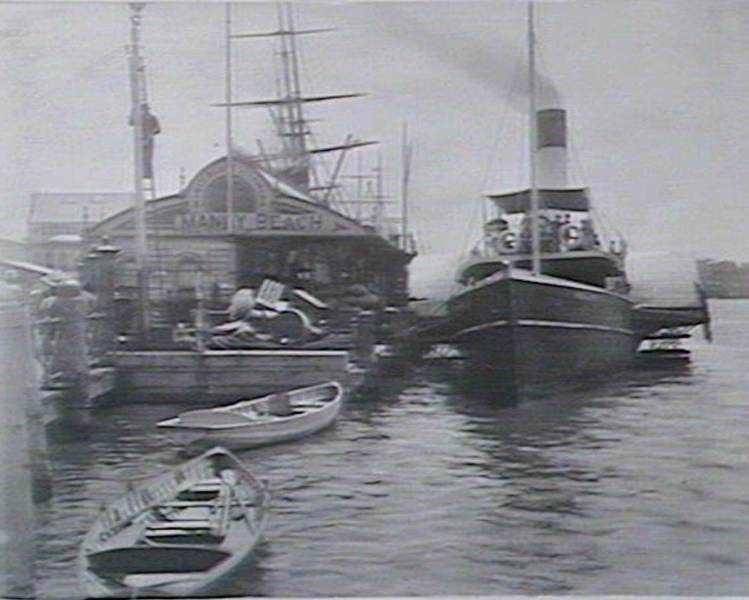
"Royal Alfred" at wharf Circular Quay, date; 9/1935 (?!), Image. No: d1_20453, courtesy State Library of NSW.
Arrived at Manly, we had an appetite for breakfast which many might, envy. This watering place reminds one of Passage, which Father Prout describes as situated
Upon the say;
'Tis nate and dacent,
And quite adjacent
To come from Cork,
On a summer's day.
The 'trap' which was awaiting us at, the hotel door, and which had been bespoken, was certainly not one of Kearey Brothers'. It had the appearance of a disused milk-cart., or a superannuated costermonger's conveyance. Our young companion did not like the look of it, but on being told there was no other available for our journey, he had sufficient of the Stoic in him to sink his personal feelings. Needs must when a Manly coach proprietor commands the drive to Pittwater. There is nothing very charming in the neighbourhood of the Pittwater road from Manly. Ducks and water fowl might find it a suitable abiding locality, but Manly-ites, if they have any regard for the future repute of their rising suburb, will extend it on the higher ground Spitwards.
Some four or five miles out of the township we overtook the 'royal mail coach' with its convoy conveying the mails and passengers to Boulton's or Newport at the head of the navigation of the Pittwater harbour. We sailed alone in this company until we crossed the Narrabeen Lagoon. As we emerged there from we descried a church, which appeared to be as well supported as the Smithy described in one of Swift's anecdotes. Seeing no residents around, we inquired where the congregation came from, but our Jehu was not a Matt Ryan. Indeed he was the most taciturn ' whip ' I ever travelled with.
Shortly after we entered upon the estate at Bilgola beach, where there is a deep leafy glen well adapted for the growth of bananas. On ascending to Bilgola Head a splendid view of the coast from Cabbage Tree Head to Barranjoee is obtained. The broad Pacific lay on our right at that moment as placid as Farm Cove. A splendid valley lay before us with the homestead of the patriarch of Pittwater, Mr. John Collins, in the distance; on the left, undulating land, well timbered.
Descending to the valley, we crossed the farm purchased by Mr. Canty, which is believed to be carboniferous. Some years ago competent judges gave it as their opinion that coal existed there. A bore of four hundred feet, made in the ground many years ago, when an attempt was made to test it, passed through strata that indicated the immediate vicinity of the black diamond. Mr. Coghlan's diamond drill would soon settle the question whether coal could be struck there. Mr. Collins's farm is situated in the valley, being flanked on the east by St. Michael's Cave and the South Head of Broken Bay, and on the West by Mount St. Mary. After doing full justice to Mr. Collins's hospitality, we sallied forth under his guidance to survey that part of the estate in which we were interested. We directed our steps towards Long Beach, nearly opposite Scotland Island, Pittwater Harbour. The land improved as we receded from the valley. Indeed we were agreeably surprised at finding soil and slope not excelled by any locality we had seen on the coast, except Irishtown, Lane Cove. My friends were delighted with their investment, and were only sorry they had not purchased more of the land.
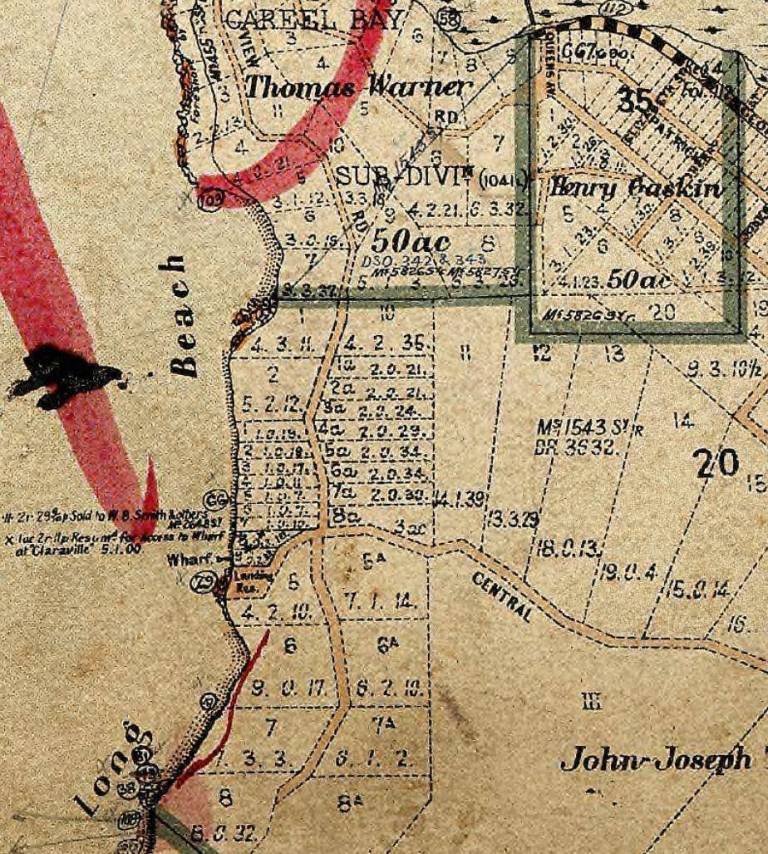
Pre- 1905 Land Titles Map - Showing 'Claraville' and 'Long Beach'. Courtesy Land Titles Office Historic records of NSW.
Pittwater estate belonged to the late Very Rev. Archpriest Therry, who bequeathed it to the Society of Jesus. It is surrounded on all sides save one by water; and it has been highly praised for its salubrity. It has a Catholic church, at which the Rev. Dr. Hallinan officiates once a month; it has also a Provisional school, attended by some twenty children. There is an incipient town called Brighton at Careel Bay, north-west of Barranjoee. The site is eminently unsuited for a township, and the sooner it is abandoned the better. A low swampy beach from which the water recedes at ebb tide, is not well adapted for settling on. A better site is that on the harbour higher up at Long Beach, where there is ‘ample room and verge ' enough, besides a moderately elevated coast and deep water. West Carbery, as we christened the place, is the site for a township.
A large block of land at Stokes's Point is reserved for a College. The scenery at Pittwater and on the greater part of the way thither is simply grand. When the road is better— (Mr. Collins informed us there is money on the estimates to form it all the way), and when a better style of conveyance is available, I know of no place or drive that will present so many attractions to the invalid, the pleasure or holiday-seeker. Everything conspires to quiet the anxieties of the mind and invigorate the body. Wooded slopes and deep ravines, picturesque views of ocean, beach, and headland, are features that would dissipate the megrims of a miser or restore peace to the mind of a rejected swain. Notwithstanding the discomforts we laboured under from the vile vehicle we had, we enjoyed the trip to and fro uncommonly well, and arrived at 7 in the evening at Manly without any mishap beyond that which a little application of Australian Ointment will remedy, as our young friend of bills and briefs said. CRUIG BARRY.11th May, 1880.
A TRIP TO PITTWATER. (1880, May 22). Freeman's Journal(Sydney, NSW : 1850 - 1932), p. 19. Retrieved from http://nla.gov.au/nla.news-article133488037

Orange Orchard, Pittwater, Charles Kerry image, courtesy Tyrell Collection on Flickr, Image No.: 30322.
A RUN TO PITTWATER
BY VIATOR.
"For what reason do the tall pine and the white poplar love to associate their branches in a hospitable shade?" was the question put by one of old who knew how to enjoy the good things of life to his friend Dellius. To the epicurean no verbal answer was necessary. The friendly trees made this grateful shade so that he might lie upon it in remoto gramine per dies festos and drink the good Falernian. This is the true way to look at life, as only the men of a fairer day knew it. For them-true beauty worshippers - the sea danced and laughed in the sunlight, the fleecy clouds were blown across the clear blue of those astounding skies, and the winds made a pleasant susurrus in the deep woods, and the birds sang, and the bees made sleepy music and sweet store of honey : for them the cataract roared, the grass grew and the violet crept across it, and the whole world lightened on its way simply to add to their pleasure. And all the wisdom garnered since by this wise old world shows that they were, in this right, by reason of philosophy, as simpler people were by intuition, who did the same. The other day I had an opportunity of spending a few dies festi on one of the many arms of Broken Bay.
To those who have not journeyed to Pittwater it is, perhaps, necessary to say that the route via Manly Beach is the most convenient way of reaching it. When the passenger arrives at Manly the Pittwater coach awaits him, and a drive of an hour and a half will land him at his destination. If the weather is gray and cold the trip should not be at- tempted. To be seen at its best Pittwater should seen in sunlight . There are several houses of accommodation about which offer the traveller all the necessary comforts. For my part I put up at the house of a friend who has one of the loveliest spots on the coast. Part of his land forms a peninsula, with deep, rich soil, in which the fig, the lemon, the orange, the olive, and the vine flourish to full perfection. There was at one time some excellent timber growing along the Pittwater road, tall, straight, sound, close-growing trees, which have for the most part disappeared under the woodman's axe within the last five years. This is a pity, but perhaps it could not be otherwise. The forest was too close to Sydney to escape the attention of wood merchants. There is still, however, quite sufficient native woodland to give the proper rustic air to these regions. How long this will be so under our present reckless system of forest destruction it is impossible to say, but those at least who own mighty tracts of virgin land along this road should endeavour to protect the native growths as far as possible from annihilation. We will regret our apathy in the matter of preserving our woods some day, when it is too late, perhaps, as the Herald has often pointed out, for anything but regrets.
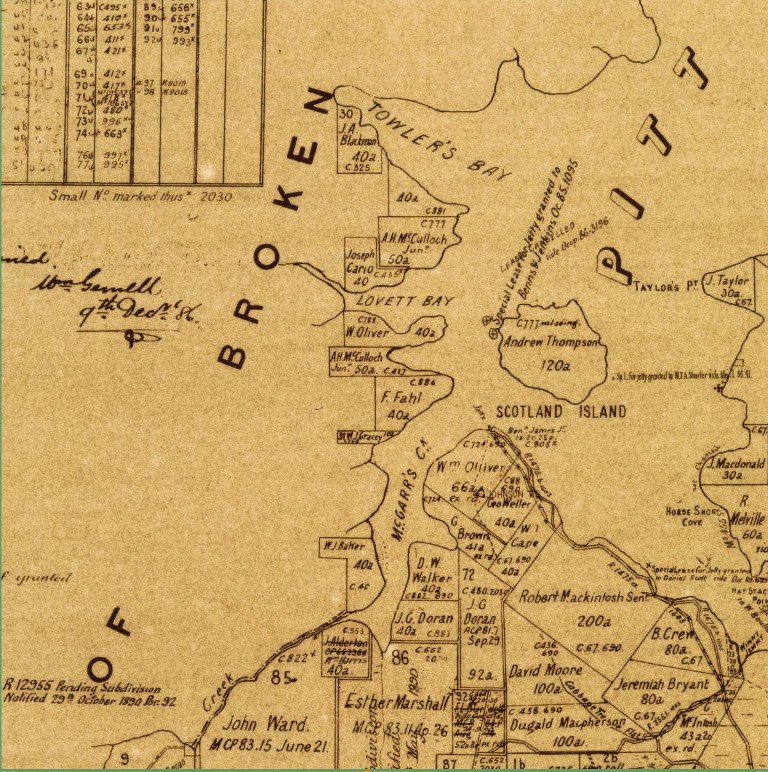
Enlargement of section from - New South Wales. Department of Lands. Parish of Narrabeen, County of Cumberland [cartographic material] : Metropolitan Land District, Eastern Division N.S.W. circa1886. MAP G8971.G46, courtesy National Library of Australia.
Something at least may be said in favour of the sense of beauty of the inhabitants of this district. Along the road every now and then the traveller may catch a glimpse of the graceful aspiring crown of tall, slender cabbage palms, which have been spared by the ruthless hands which have destroyed so much besides that was beautiful. Two or three handsome growths stand like sentinels on either side of the road, though the army which they guarded has long since faded away - ended in smoke probably. The cabbage tree splits easily into light serviceable planks, and this made it much sought after for the gunyah of the early settler. When dry it burns like tinder, and these two fatal qualities have been its ruin. A few, as I have said, still remain. One magnificent specimen, standing back some distance from the road, must be from 80 to 100ft in height, and with its plumy head and symmetrical trunk visible among the amorphous forest shapes about it, is full of graceful tropic suggestiveness. There are one or two other species of dwarf palms scattered about, which have failed to attract the attention of "flower show" prospectors - a class of people whose ruthless hunt after specimens is responsible for a large proportion of the destruction which has visited our most ornamental native plants.
The road traverses the Narrabeen lagoon, an imposing marine "billabong," such as our coast has several notable examples of. These are connected with the sea, either by a shallow channel with a sand-bar across it, or as in the case of the Narrabeen lagoon and that of Curl Curl nearer Manly, are severed from the sea, by a sandbank, which, however, offers no impediment to the influx of the sea under the influence of a spring tide or a heavy easterly wind. These are the true nursing grounds of our young fish. Within those charmed waters the shark may not enter to disturb their peaceful inhabitants. By reason of the clear sand bottom they are beloved of the sole, the sand-flathead, the whiting, and the sand mullet which reproduce in the tender complexions of their bodies something of the transparency of the waters and the whiteness of the sand. Consequently the Narrabeen is a favourite resort of camping parties, which, rumour hath it, have never yet gone unrewarded from its shores.
There is a pretty legend about the name of this lagoon, which it is said was first born by the dusky daughter of a lord of the soil and a chief of his people. This chief had planned it in his black head to destroy a party of white men located at this spot; but Narrabeen flew to Manly and informed the authorities, bringing back help in time to rescue the party. This pretty legend does not state that Narrabeen was in love with one of the white men, but surely this must have been. What became of Narrabeen is not stated, but knowing the character of some of the early settlers, and the manner in which the blacks were treated, it unquestionably could not have been ill for her if she found an early grave in the clear water of the shining sheet which bears, and shall always bear, her name.*
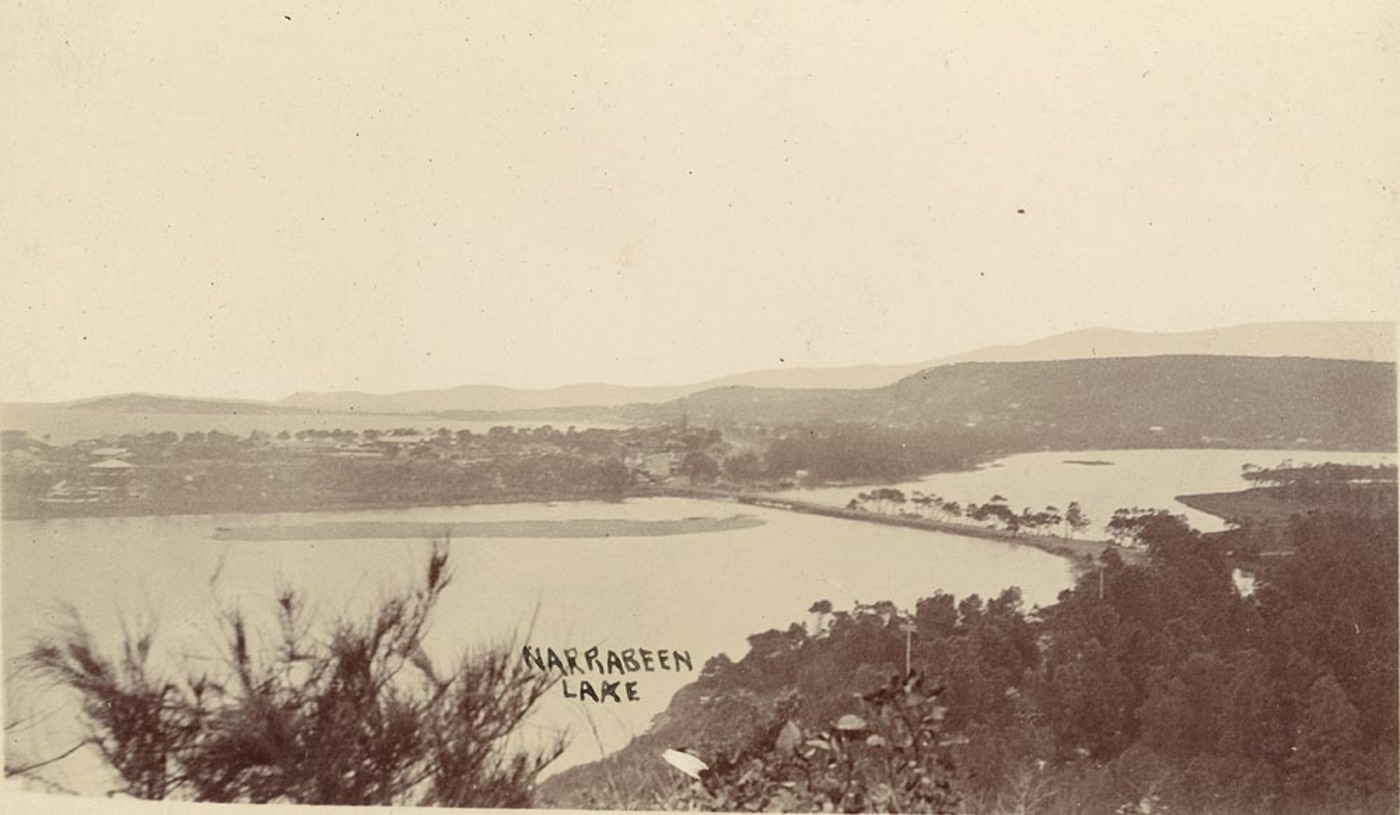
Narrabeen Crossing. Image No.: a106063h From Scenes of Narrabeen album, ca. 1900-1927Sydney & Ashfield : Broadhurst Post Card, courtesy State Library of NSW.
Across the lagoon in a direction different from that taken by the road the telegraph line takes a short cut, passing the water in a few giant strides. Not very long ago the coaches had to pass through the water too, and this must have conduced to many a good ducking suffered by the traveller of the past. On some of the lagoons, which are plentiful along this road, the black swans congregate at certain seasons, probably when the hot breath of the drought has made them fearful that the inland waters were about to forsake them altogether, as Lake Albert and other extensive sheets of water actually do in a season of prolonged dry weather. From time to time, from an elevation over which the road passes, the traveller catches a view of the coast as far as the famous headland of Barranjoey. Bluff after bluff fronts the sea in curious and beautiful regularity, now calm and clear in contour as the cuttings in a cameo, now veiled in a light blue mist, which bestows harmony and tone on the scene, and whose impermanent curtain every breath of sea-borne air momentarily dissipates. On a bright, clear day this view, which may be obtained from the hill lying between Fairy Bower and Manly Beach, is superb. But our two stout horses stay not for the picturesque, and we soon arrive at Pittwater, an arm, as every one knows, of Broken Bay.
This latter inlet is for once well named. Equally happy is the title bestowed on Lion Island, that grim image of stone rudely shaped by Nature to keep perpetual watch and ward over the picturesque waters within, and appropriately gazing over the ocean, from which the white sails and black smoke of the enemy of our long tranquillity are some day to spring. According to General Schaw the defence of Sydney will be incomplete until Broken Bay is strongly fortified. Was it to emphasise the weakness of the place that this Titanic lion was placed in frowning strength immovable in the war of winds and the whirl of waters? Absit omen. It may yet be renowned in history ; it surely will in romance. What significance could be drawn from its apparently meaningless symbolism Hawthorn has shown us in the " Great Stone Face." To the majority of the world, however, this rock is like the rock in the desert from which the Israelitish leader smote the living water. We poor exiles might touch it with our little wands for years, and all in vain, until the due hierophant comes along and strikes it with his sacred force, when, behold, a spring of glittering song or sparkling prose gushes out which we all rush to drink. And forevermore the spring is as much ours as his who caused its pure initial flow.
After a journey there is nothing more pleasant than the after-tea gathering about a glorious wood fire, sipping the mellow liquid that glimmers in polished glasses, while every head is dimly seen bulking through a nebulous halo of aromatic smoke. My host had Theosophistic tendencies, and before long the conversation turned on the doctrines of the esoteric Buddhists. It is curious that quite a number of intelligent young Australians appear to be opening their mouths to swallow this many-humped camel of the Orient. Men who scorn the faith which accepts the Christian miracles are willing to receive as truth the tremendous miracles of the Theosophist, and do this without any apparent sense of the incongruous. Theosophism, however, can only be a vogue. It will never lay hold of Western minds as it has fastened on the men of the East. It has its foundation in the mind and not in the heart, and consequently it is a system and not a religion. But it is curious to note that it is growing here - most curious to hear its strange esotoric doctrines discussed in the spirit of a disciple in this isolated cottage, with all about it the mild growth of Australian life. How near we are to primitive nature is evidenced by the presence of a little black lizard, which, attracted by the warmth, comes out of some secret hiding-place and creeps towards the strange and beautiful fire which lures it to its doom. Outside, the southern stars blaze in the lucent night with a brilliance undimmed by a day of smoke. The dark waters sleep beneath, tranquil and secret.
There is a philosophical foreigner inhabiting these regions whose wont it is to row out on the water in his boat and fill himself up with whisky. His last wilful acts are to set the sails of his boat and then lie down to sleep, letting his bark go whithersoever the winds of heaven list. For hours this fatalist drifts hither and thither before his boat is driven to land. It is a whimsical enjoyment truly, but one that instinctively commands respect. He in his boat and we on the shore are in much the same position, drifted hither and thither, willy nilly, by winds and currents known not of till our boats ground upon the shore. We talk about the insularity of the Englishman, while humanity itself is, and always has been, insular. When the first man gazed on the first stars ever beheld of human eyes, he probably imagined they were made for his delight. We know that of old it was firmly held that the sun was a satellite of the earth, and even now it is the common belief that the little spheroid on which we have our being is the control globe of a system as wide as God's own mind - the only planet upon which life is found. Those stars above most of us think are shining deserts made without a purpose, or, if for a purpose, for that of shedding an infinitesimal ineffectual portion of their lustre on our inefficient eyes. All this springs from the inborn insularity of the race. In the end, when the whole scroll of creation is unrolled, as it may be, before our purged vision, how small a portion of it all this little earth of ours may prove to be. And yet, despite this possibility, how infinitely cock-sure mankind is, and always has been, about its own importance. It is a positive relief for one who perceives this weakness, and who probably shares it, to think that somewhere in a starless roadway of space, unnumbered millions of leagues away, a huge comet may even now be on his way to batter the earth and its egotistic inhabitants to dust, smiting one side of the globe before the inhabitants of the other are conscious of its dread appearance in the sky. Would such a planetary catastrophe cause a single quiver in the nerves of the universe ? And yet there are those who believe that earth is the universe. We may be sure that the philosophic foreigner aforesaid is not one of these, but has a due conception of the helplessness of the race of which he is a distinguished atom. It is this Universe itself which the modest theosophist wishes to make the stool of a foot which must wear boots, and is liable to corns - the elongated degenerated hand, perhaps, of the tertiary troglodyte.
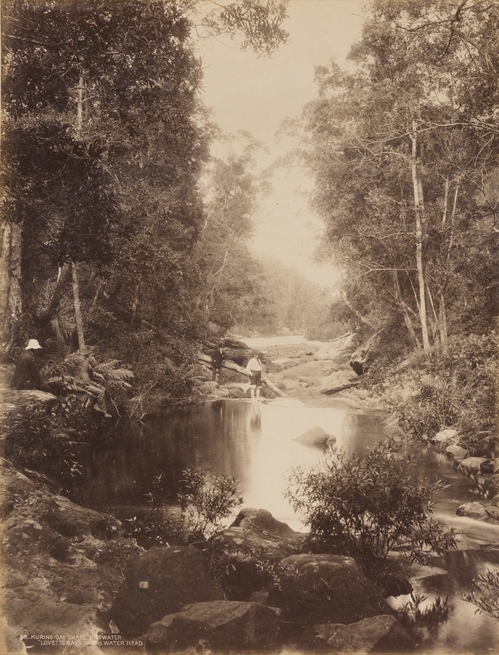 Right: Head of Lovett Bay - from Photographs - New South Wales, 1879 - ca. 1892 / N.S.W. Government Printer. Image No.: 294068h, courtesy State Library of NSW.
Right: Head of Lovett Bay - from Photographs - New South Wales, 1879 - ca. 1892 / N.S.W. Government Printer. Image No.: 294068h, courtesy State Library of NSW.
In the cool early morning I took a stroll through the garden and orchard surrounding the house, on whose trees late oranges and lemons of unusual excellence were still pendant. Down by the waterside were millions of oysters, whose careless profusion suggested a flouted industry. A well-worn path under giant gums and sassafras trees led to a noted part of the grounds. Here was a waterfall tumbling fifty foot in smoke-like spray. The whole face of the cliff which was watered by the spray was covered with clinging plants, ferns, and funny looking creepers. About this spot the vegetation was as beautiful and luxuriant as I ever remember having seen it in the mountains. There were fern trees, as tall as the stateliest in the mountain gullies. Bangaloes of magnificent size, and 40ft, upon the trunk of a glorious blue gum there was a mass of Staghorn ferns as big as small cottage. From the trees the rope-like Supple jack descended, and the bushes about fairly blazed with blossoms. So thick was the growth that it was impossible to force a way through it. A fairer spot there is not on the coast anywhere in the vicinity of Sydney.
A huge Government reserve runs, back from the shores of Pittwater to Gordon, and this also was unusually brilliant with all kinds of our beautiful, barbarously-named bush flowers. Tearing through this vegetation was splendid work, if somewhat trying to the clothes; and on reaching the elevated ground overlooking Cowan Creek: the guerdon was well worth the pleasant travail. Hundreds of feet below, blue as turquoise, Cowan Creek nestled in dark green environing hills. It is sea-blue in colour as well it might be, for it is an eccentric arm of the sea, which winds its way far into the bowels of the, land, being, in fact, the longest arm of Broken Bay. Anyone, however, would mistake it for a fresh-water river. On those breezy heights the draughts of fresh air to be inhaled are delicious. Over miles of eucalyptus leaves a deep balsamic gale rushes up charged with the health-giving qualities that the old settlers found so soon in the eucalyptus woods. After a long and arduous climb, of several hours I found almost instant recuperation in this elevated air, interfused with forest perfumes. It would be hard to be sick under the influence of this " balsam of the forest". A medical friend informed me that he got rid of an unusually persistent cough of many months duration by going to the mountains and chewing the young eucalyptus leaves every day. The virtues of the "gum-tree " are not unrecognised, but are not all known yet, and its place in medicine is, perhaps, destined to be one of great importance.
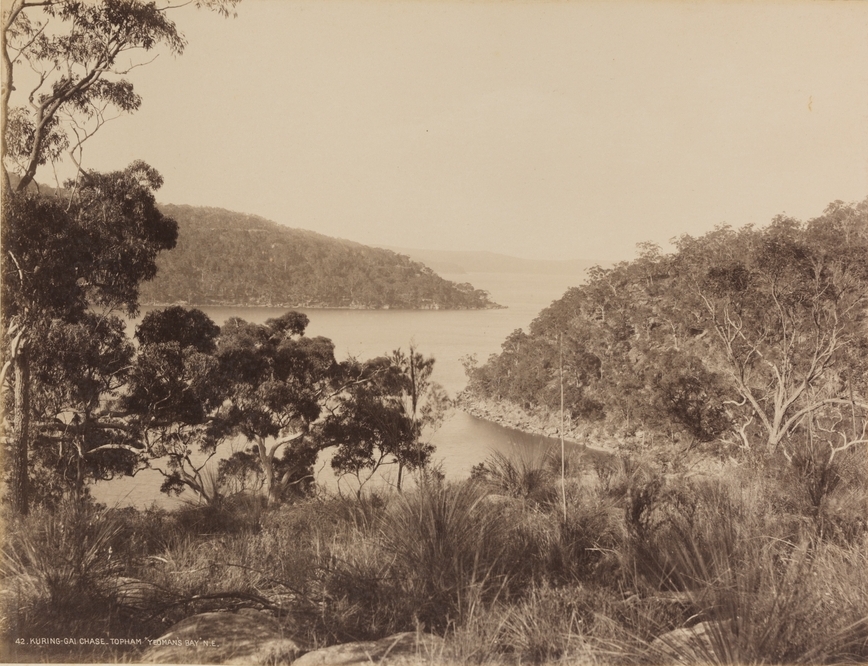
Topham - Yeomans Bay, from NSW State Library Album - Photographs - New South Wales, 1879 - ca. 1892 / N.S.W. Government Printer. Image No.: a924070h, courtesy State Library of NSW
On the rock beneath my feet were some curious drawings. A glance revealed them to be specimens of the initial artistic efforts of the Australian aboriginal. There were two figures - a bird and a fish - clumsy enough in all faith, but not without a close resemblance to the living originals. Some day they will have a deep interest to Australians, as relics of the old inhabitants and their totemistic religion. Beside the art glories of perfect Greece, how poor they are; and yet, as mythologists tell us, many of the religious rites and legends of the ... Australian blackfellow have their counter- parts in Greek myth. Truly, there is nothing new under the sun, and man is always man. The same instinct which moved the chisel of Phidias and the pencil of Apelles directed the pointed flint of the dusky artist of these rude rock sculptures.
As the setting sun fires splintering crag and bush-grown hill, and flings a purple glow over far inflowing waters, the birds twitter in one choral burst of song, and then grow still; and all the voices of Nature but one are still. The mists troop forth from their hiding-places and sit on the vacant thrones of the sunlight, and a dull insistent moaning down the bay tells us that the sea's sleep is disturbed by dreams of coming storm. The dawn sees us once more on our way to the "big smoke."
A RUN TO PITTWATER. (1889, September 21). The Sydney Morning Herald (NSW : 1842 - 1954), p. 7. Retrieved from http://nla.gov.au/nla.news-article13739295
* This is folklore, unproved.

A View of Pittwater from Ku ring gai chase - TOURIST RESORT RAPIDLY INCREASING IN POPULARITY. (1929, January 21). The Sydney Morning Herald (NSW : 1842 - 1954), p. 12. Retrieved from http://nla.gov.au/nla.news-article16525194

Mc Carr's Creek - From Album - Scenes of Pittwater, N.S.W., ca. 1900-1927; Sydney & Ashfield : Broadhurst Post Card, courtesy State Library of NSW. Image No.: a106169h
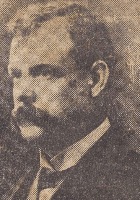 Mr. P. E. (Patrick Edward) Quinn, the member for the Bligh (a part of the old East Sydney electorate), is a native of Sydney. At the age of four he was sent to the Catholic Denominational School of St. John's, Kent-street. Later he had the advantage of the training afforded by other city schools. At 14 he secured a junior position in the Civil Service, but being ambitious to make a mark in a learned profession, resigned from the Service and studied under the late Mr. Sheridan Moore, and subsequently under Mr. Frank Butler, B.A., with the view of qualifying for the legal profession. Meanwhile he became a contributor to the FREEMAN’S Journal and the Bulletin, and at 19 edited the Namoi Independent (Gunnedah). A few months later he controlled the Maitland Mail. Returning to Sydney, the young journalist lectured on literary subjects. He also displayed power as a political speaker. Having given up legal aspirations, Mr. Quinn devoted himself entirely to press work. For 15 or 16 years he has been an occasional contributor for leading articles, reviews, and poems to the Freeman's Journal. A few years ago Mr. Quinn wrote a series of excellent articles under the pen-name of ‘Viator' for the S. M Herald. His hand has also appeared in the Herald's editorial columns. While contributing to numerous papers, including the Star, Mr. Quinn found time to write a variety of short stories, a collection of which will shortly appear in book form. He is the author of 'The Jewelled Belt,' an interesting detective study. Mr. Quinn has not yet published a volume of verse, but he is responsible for the libretto of the ' Captain Cook' cantata, set to music by Mr. J. A. Delany, and rendered with conspicuous success on several occasions by the Sydney Fiedertafel. In various debating societies of his earlier days, Mr. Quinn was a prominent member and effective speaker. THREE NEW MEMBERS. (1898, August 20). Freeman's Journal (Sydney, NSW : 1850 - 1932), p. 17. Retrieved from http://nla.gov.au/nla.news-article115388842
Mr. P. E. (Patrick Edward) Quinn, the member for the Bligh (a part of the old East Sydney electorate), is a native of Sydney. At the age of four he was sent to the Catholic Denominational School of St. John's, Kent-street. Later he had the advantage of the training afforded by other city schools. At 14 he secured a junior position in the Civil Service, but being ambitious to make a mark in a learned profession, resigned from the Service and studied under the late Mr. Sheridan Moore, and subsequently under Mr. Frank Butler, B.A., with the view of qualifying for the legal profession. Meanwhile he became a contributor to the FREEMAN’S Journal and the Bulletin, and at 19 edited the Namoi Independent (Gunnedah). A few months later he controlled the Maitland Mail. Returning to Sydney, the young journalist lectured on literary subjects. He also displayed power as a political speaker. Having given up legal aspirations, Mr. Quinn devoted himself entirely to press work. For 15 or 16 years he has been an occasional contributor for leading articles, reviews, and poems to the Freeman's Journal. A few years ago Mr. Quinn wrote a series of excellent articles under the pen-name of ‘Viator' for the S. M Herald. His hand has also appeared in the Herald's editorial columns. While contributing to numerous papers, including the Star, Mr. Quinn found time to write a variety of short stories, a collection of which will shortly appear in book form. He is the author of 'The Jewelled Belt,' an interesting detective study. Mr. Quinn has not yet published a volume of verse, but he is responsible for the libretto of the ' Captain Cook' cantata, set to music by Mr. J. A. Delany, and rendered with conspicuous success on several occasions by the Sydney Fiedertafel. In various debating societies of his earlier days, Mr. Quinn was a prominent member and effective speaker. THREE NEW MEMBERS. (1898, August 20). Freeman's Journal (Sydney, NSW : 1850 - 1932), p. 17. Retrieved from http://nla.gov.au/nla.news-article115388842
Patrick Edward Quinn was the brother of Roderic Joseph Quinn, a celebrated Australian and Sydney poet. A member of the Dawn and Dusk Club of the late 1890s. P E Quinn also wrote poetry, as did another brother. He was buried at Manly Cemetry. Daughter Marjorie also became a poet of some renown and one of the champions of women's literature in Sydney. A book of his brother's poems is below. More on the family may be read HERE and on Mr. P E Quinn and his daughter Marjorie HERE.
The Dawn and Dusk club was formed around 1898 in Sydney, Australia by poet Victor Daley. Foundation members of 'the Duskers', a small and exclusive group of friends were Daley, Fred J. Broomfield, James Philp, Herbert Low (journalist), William Bede Melville (a reporter for the Sydney newspaper, The Star),Angus Sinclair (writer), Bertram Stevens and Randolph Bedford.
The club met at Broomfield's home on the corner of Ice Road and Great Barcom Street, Darlinghurst, near St Vincent's Hospital, Sydney about September, 1898. Daley was elected 'Symposiarch' of the Duskers and the seven 'heptarchs' were Lawson, Stevens, Nelson Illingworth, Frank P. Mahony, George Augustine Taylor, Con Lindsay (journalist), and Philp, who drafted the rules. Artist Norman Lindsay was also a member. Truth magazine publisher John Norton called them "a band of boozy, bar-bumming bards".
"Now we shall go up McCarr’s Creek to a little inlet called Brown’s Bay. George Brown and his family were the owners of the 41 acres estate "Waterside", a grant made in 1880. His house of weatherboard stood on the hillside, reached by a zig-zag path from the little stone jetty. The estate extended right to the head of the bay, where there is a gully, clad in various kinds of flora interesting to the botanist. Two old peach trees grew in front of the verandah, which was supported on pillars and at the head of the bay, passion-fruit vines grew over the rocks and trees. A track from Church Point led to it and on the way round exquisite glimpses of the creek were obtained through the gum-trees. I often stayed with the Browns at this old house and in the years 1909-10, it was a sequested spot, quite isolated even from the few inhabitants of Church Point. - JSN Wheeler, Some Old Families Of Pittwater, n.d.
DEATH Of A PIONEER COWRA. Wednesday. Mrs. Elizabeth Chave has died at the age of 92. Her husband, the late. Mr Frederick Chave travelled by bullock dray from Parramatta to Warren where he acquired Dungaleer Station. Some years later he returned to Sydney and settled at Pittwater. At one time Mr Chave owned Kuring-gai Chase. Mrs Chave is survived by ten children, 25 grandchildren, and ten great-grand-children. DEATH OF A PIONEER. (1934, August 2). The Sydney Morning Herald (NSW : 1842 - 1954), p. 10. Retrieved from http://nla.gov.au/nla.news-article17095056
The Royal Alfred paddle steamer has been purchased from the Port Jackson Steam Co, by Mr. Halstead for £1500, and the ketch, Maid of Australia, has been purchased by Mr. F. Chane, of Pittwater for £100. The Young Dick, steamer, has been purchased by Mr. F. Silva, of Watson’s Bay, from Mr. B. Wanning, for £1000. Along the wharves. (1885, February 17). Evening News(Sydney, NSW : 1869 - 1931), p. 4. Retrieved from http://nla.gov.au/nla.news-article111182893
The coaster Maid of Australia has been sold by Mr. G. Crestenoff to Mr. F. Chave, of Pittwater, for £100. IMPORTS.—FEBRUARY 14. (1885, February 17). The Sydney Morning Herald (NSW : 1842 - 1954), p. 6. Retrieved from http://nla.gov.au/nla.news-article28367085
Maid of Australia, for the Hawkesbury; Mary Jane, for Broken Bay ; Missis, for Cape Hawke-; Maggie Scott, for Brisbane Water;' . Srlvañus, for Jervis Bay ; Rebecca, Hirondelle, Hebo, Vibilia, and Clara, for Newcastle; Dairy Maid, for Shellharbour; Peahen, for Pittwater. CLEARANCES.—June 21. (1870, June 22). Empire (Sydney, NSW : 1850 - 1875), p. 2. Retrieved from http://nla.gov.au/nla.news-article63108439
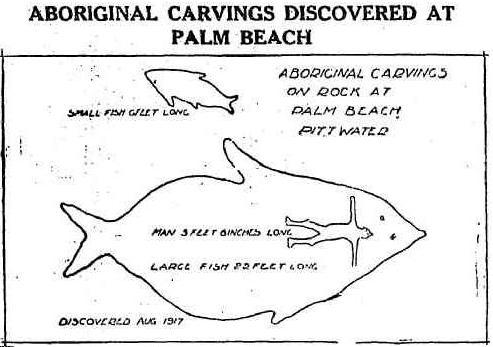
ABORIGINAL CARVINGS DISCOVERED AT PALM BEACH. The outline drawings represent two kinds of fish and a man, cut on a flat rock on the hill between Sand Point, Pittwater, and Cabbage Tree, Boat Harbor, Palm Beach, Barrenjoey. The fish measures 22ft, the man 5ft 6in, and the smaler fish 6ft long. They have excepionally good outlines, and are better shaped than any others yet recovered,
The Hawkesbury standstones, by reason of their comparative softness, offered exceptional facilities to the coastal tribes of our aboriginals to display their art in pictorial drawings, as there are many in the Port Jackson and Hawkesbury
districts. It is not known what age these carvings can be, but many hundreds of years must have elapsed since they were made. The drawings were discovered by Architect H. A. Wilshire and Stonemason J. Booth, who were looking for building stone on the Barrenjoey Company's property at Palm Beach. The company has decided to preserve the carvings for all time. ABORIGINAL CARVINGS DISCOVERED AT PALM BEACH. (1918, August 9). The Mirror (Sydney, NSW : 1917 - 1919), p. 5. Retrieved from http://nla.gov.au/nla.news-article136729060
A BRIEF RESPITE, OUR TRIP TO BROKEN BAY.
Written for the Evening News by “Lanyard”
The wind blew lightly from the west; the bright sunshine of our Sydney winter tempered the clear, keen, crisp atmosphere, and the skipper, crossing the harbor on the way to his gloomy, chilly office in the city, heard 'the sea a-calling,' without the faintest prospect of his being able to obey that call. But, as luck would have it, the metaphorical straw had not arrived wherewith to make the metaphorical bricks: so, having found in me a willing mate he set sail for Broken Bay. Precisely at 25 minutes to 2, he squared away off North Head, with a remark to the effect- that all the telephones in the world could not get him back now; and the boat with a following wind and sea— the wind now blew from the south— was soon dancing past the sandstone walls of Bluefish. If our passage to the Bay was uneventful, it was pleasant enough running along the coast, past bold headlands, sea-swept beaches, and foam-covered reefs; and the wind, dead aft, with a confused sea, made it a matter of some interesting nicety to keep the boat fairly on her course without jibing. At five minutes past 4, we were abreast of Barrenjoey, which stood out clear against the cloudless sky, every clump in its thick scrub clearly defined by the afternoon sun, the sea breaking into white foam and spume at Its base. A kettle of water for afternoon tea was boiled, soon after we had hauled a wind to beat up to Bayview, which we talked confidently of reaching in daylight, but the wind gradually dropped, and but for an occasional touch of a sweep we should not have reached our destination that evening. And it was cold — so cold that when we had dropped anchor off the pier at Bayview we were glad to sit round the Primus stove in the little cabin while our evening meal was being cooked. One of our Bayview friends came on board, and told us all the local news, little things being magnified into importance, as is usually the case in small places. But the fresh air had been too much for us, and he left us early, for we were ready to sleep, and with the sound of the waves breaking over on the rocks we lay down on our settees for a long, peaceful sleep, which, only the morning sun shining into the cabin disturbed. Then one of the events of the week at Bayview took place— the Narara and her rival, the Hawkesbury, arrived, and much of the population of Bayview gathered on the pier to watch the steamers discharge such parts of their cargoes as had been booked to Bayview. The steamers, then went on their way, and the pier was again deserted.
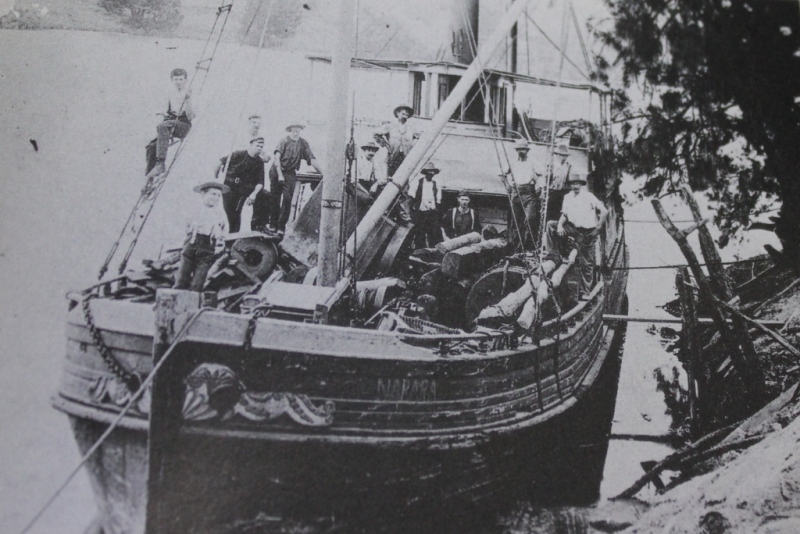
S.S. Narara, circa 1905, from and courtesy of Eric Mitchell collection.
After a simple breakfast, and a smoke while we washed up, we landed, and looked into the little store, which does duty as a post office, and many other things. We strolled into an orange grove, ate the fruit straight from the trees, and loafed the morning away in the sunshine and out of the wind. Lunch with some friends was followed by our taking them but for a short sail in the boat. We drifted off Bayview, and admired from the water the tall, well-wooded cliffs— barriers against the southerlies, sou'- westers, and westerlies, which make Sydney sometimes bleak and unpleasant in the winter; the shore to Church Point bathed in the afternoon sun, the fine outline of Scotland Island, the white beach at Smoky Corner; Barrenjoey, black and grim; Mount Elliott, mid channel, like a huge lion guarding the entrance of the Bay; and in the blue haze of distance the volcanic shaped hills beyond Brisbane Water. All was calm and still; the blue smoke from the chimneys of the sparse houses rose undisturbed- even by a zephyr. An occasional lowing of cattle in the distance, the deep, sweet note of a magpie, seemed only to add to the peacefulness, and we city workers revelled in it. The motor-bus from Manly brought us one of the ship's company and a hamper. We wandered through orchards and orange groves during the rest of the afternoon, and in the evening dined with our friends. It was comfortable sitting round a gum-log fire, but an early start was imperative, as we wished to do some outside fishing on our way home, and we thought it advisable to have a few hours' sleep before getting under weigh.
At 1 a.m. two more of the ship's company made their appearance; they had walked the 13 miles from Manly, and were ready for the cup of Mocha we offered them, and anything else they could get, and particularly for bed. At 2 a.m. we weighed anchor. The skipper had wrapped himself up in a Tasmanian bluey, with a rug round his legs, under which he had placed a lighted Dielz lanthorn. A member of the crew, who had promised to sit up with him, confessed that the oranges he had eaten 'had him beat,' so the skipper sat alone and silent, whilst the boat, moved more by the sluggish tide than the light westerly, which at times died away altogether, drifted down the long, dark bay towards the deep, red light on Barrenjoey.
Near the mouth of the Hawkesbury the breeze freshened, and at 5 a.m., with ebbing tide and wind aft, the boat rose to the swell of the ocean, and glided out, of the Bay, to the accompaniment of the sea lazily breaking on the rocks. 'The stars were jewels that morning, but they paled before the coming dawn. When we arrived off the fishing-ground, the sleepers were awakened, and before the sun had risen we had caught a couple of fish of the right color. I leave the sunrise severely alone; only such a hand as that which penned the tradewind sunset in 'Vailima Letters' could paint the tints and draw the pictures that appeared in the long, low bank of clouds in the east.
We had to change our position, however, several times before we found the sport exciting enough. All this time the wind had been edging round to the south, and in spite of appeals - for another quarter of an hour's sport, the order 'Up lines!' was insisted on. We then began our long beat up the coast in a failing wind. As it was, the sweeps alone brought us in from North Head, and it was 3 in the afternoon before we sat down to a merry little lunch in Ladies' Hall.
The tide was running out, there was not a breath of wind, and that afternoon-feeling that a good lunch engenders had possession of us; so it was not with any intention of pushing the boat home that we put out the sweeps. There was a tow-line ready; the sweeps were merely a device to make some passing motor-boat owner sorry for us. No less a personage than the vice-commodore of the R.S.Y.S. took compassion on us, and we were soon alongside our shed. There are some who will scoff at the idea of writing about our modest little trip, which is one every Sydney boating man does time after time; there are some who, from the height of their floating palaces, will look down on our poor little ship, and sneer at our paltry voyage of 20 miles up the coast. I can only hope they will be as happy as we were, and that fair winds will waft them to more beautiful scenes; they will, however, have to go much further to find them.
A BRIEF RESPITE. (1907, August 10). Evening News (Sydney, NSW : 1869 - 1931), p. 12. Retrieved from http://nla.gov.au/nla.news-article112640051
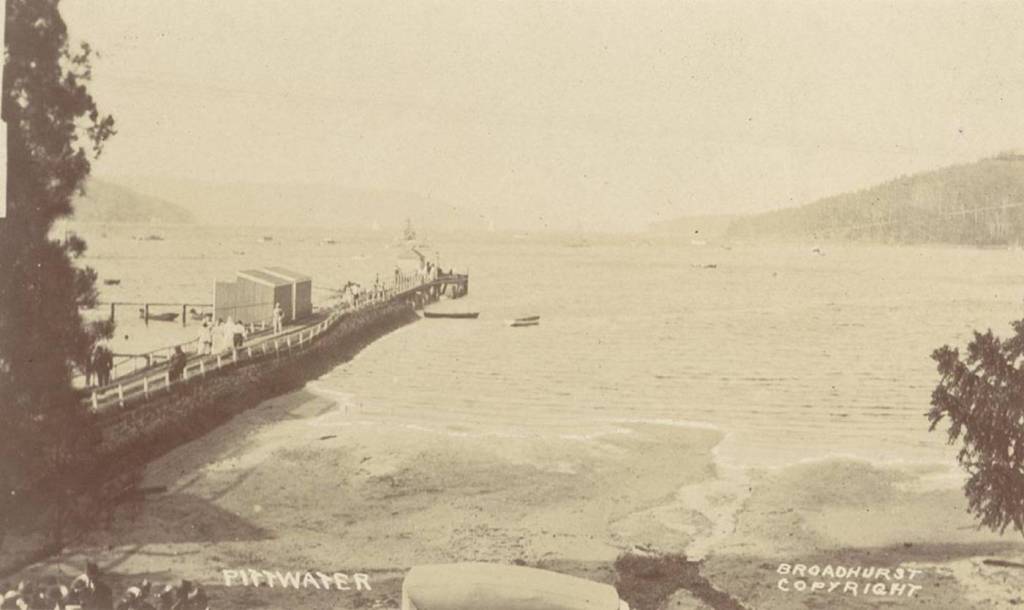
Bayview Wharf, circa 1909. Broadhurst Image 11061661h, courtesy State Library of NSW.
